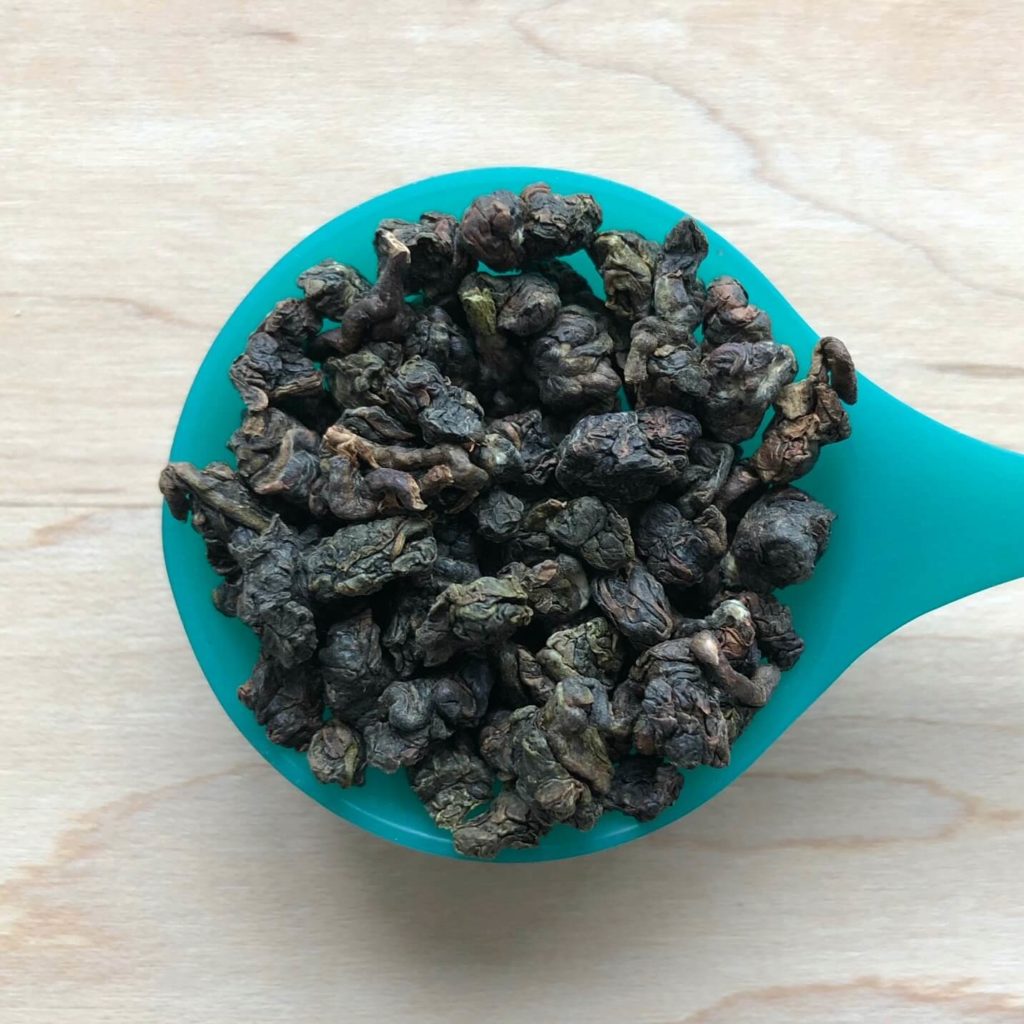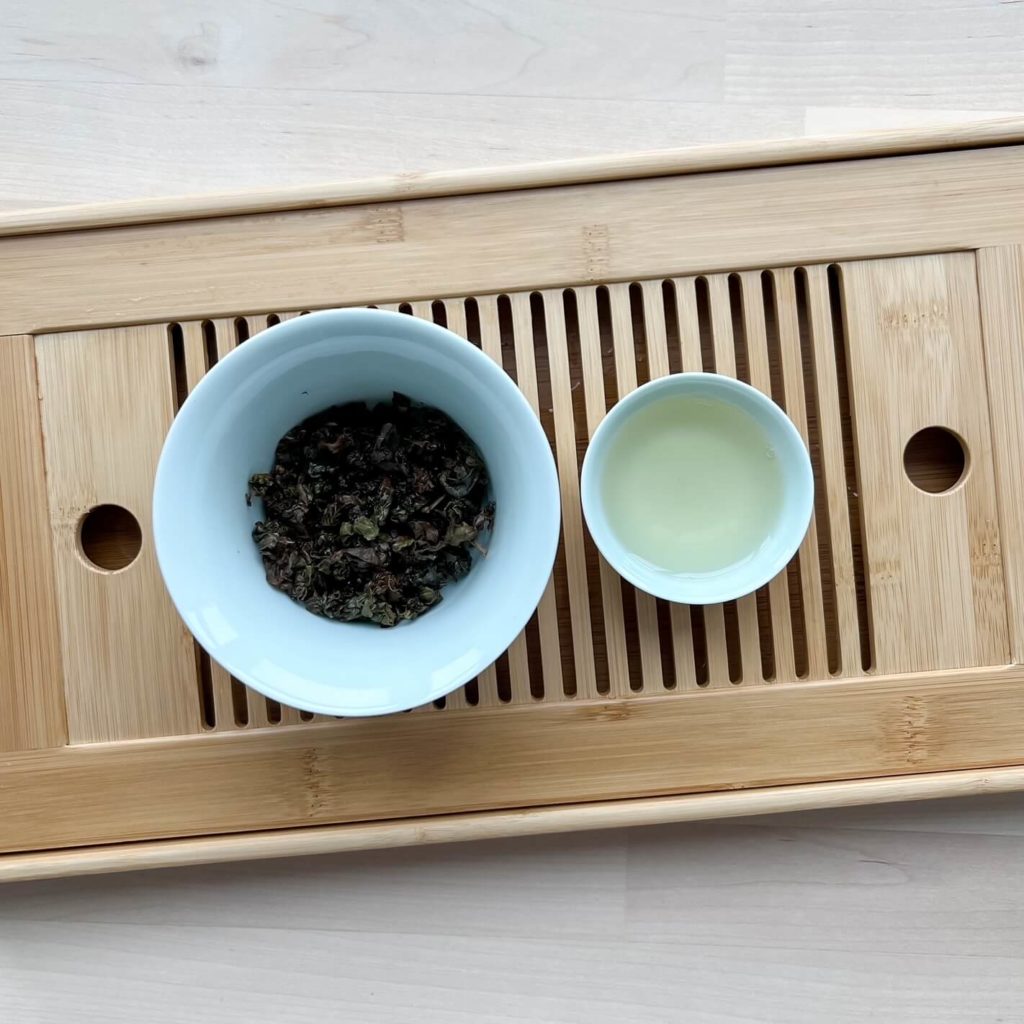
I wasn’t aware there were other bug-bitten oolongs like Oriental Beauty (or Bai Hao). So, I wanted to see how this tea would taste!
Description: “Its amber liquor is velvety and well balanced, with fine notes of spice bread (cinnamon) leading to a soft sweet finish.”
Instructions: 1 teaspoon/3 grams | 95°C | Rinse 5- 10 seconds | 4 – 5 minutes
Review: Oriental Beauty is a well-known Taiwanese oolong because it is commonly bitten by a leafhopper (Jacobiasca formosana). When this happens, the tea plant secretes hormones to defend itself, creating a unique aroma and flavour. So, seeing that the leafhopper is in the vicinity of this tea, I was interested in seeing if it would also have a sweetness to it.
When it comes to brewing recommendations, Camellia Sinensis Teahouse’s website provides gong fu and Western-style brewing suggestions. Since I purchased a sample amount of tea, I had enough to brew gong fu once and the remainder Western style.
The dry leaves were small tightly rolled dark green balls and smelled like fresh cut grass.
Gong Fu Cha Technique

Pre-warmed gaiwan: After warming the gaiwan since it was cold where I live, I added the dry leaves to the vessel. The warmed leaves smelled sweet and caramel.
Quick rinse: Despite the recommendations suggesting it, I forgot to rinse the tea for 5 to 10 seconds.
Infusion 1 (40 seconds): After brewing the tea (and allowing it to brew slightly extra because I forgot to rinse), the pale amber yellow liquor had a nutty, roasted, woody, and caramel smell. The taste was initially like molasses and developed a slight grassy/vegetal undertone.

Infusion 2 (25 seconds): A mild roasted charcoal smell remained and the liquor was slightly darker in colour. The taste started woody and roasted, with a lingering sweetness and dryness at the end of the sip. A green grape taste remained in the mouth. When cooled, the liquor was sweet with a roasted nutty taste. By the second infusion, the leaves had mostly unfurled.
Infusion 3 (35 seconds): The brewed dark amber brown liquor had a roasted, woody, and sweet taste, as well as notes of bread and molasses. When cooled, the liquor had a stronger roasted note. The leaves had fully unfurled.

The wet reddish dark olive leaves and steams were fully unfurled and smelled sweet, woody, and roasted.
Teapot Method

Since I had a limited quantity of tea, rather than brewing a temperature in between the recommended steeping times like I typically do, I decided to brew at both extremes to see what flavours would develop. Since I had forgotten to rinse the gong fu session, I made sure to rinse. I normally do not rinse for teapot/mug style sessions.
With the shorter 4 minute steeping time, the liquor smelled like flowers, apple cider, and mildly roasted. The colour was a deep amber-brown colour. Like how it smelled, the tea was sweet and woody with little astringency. When cooled, the sweet apple cider and roasted notes were more pronounced.
For the longer 5 minute steeping session, the liquor also brewed into a dark amber-brown colour. When the tea was hot, the taste was not very noticeable. However, letting it cool slightly, the flavours became more distinct. At first sip, the liquor had a strong apple taste, however, it was quickly overcome by a honey-like sweetness and a faint woody note at the end of the sip. The liquor was more drying but had a syrup texture that coated the mouth. Letting the liquor cool even more allowed for a delicate sweetness that reminded me of red dates and apples but was also more woody and drying at the back of the throat.
Overall
While I mentioned, Oriental Beauty, when I looked through my stash, I sadly realized I did not have any on hand to do a comparison. Regardless, this tea was on the delicate side for me. In the past, when a gong fu session brewed was mild tea, normally the teapot/mug brew would have a stronger taste. However, techniques resulted in a similar tasting tea, despite trying to brew the teapot/mug style even with the higher steeping recommendation. If I had to pick a brewing method, I would pick gong fu as it was able to elevate the flavours more.
Despite its delicate nature, the tea was sweet and fruity, which is a common trait of Oriental Beauty. This may be a nice tea for people who enjoyable for people who like a sweet and lighter tea profile or Taiwanese oolongs (3/5 rating).
- Type: Oolong
- Origin: Taiwan
- Caffeine: Unknown
- Ingredients: Qing Xing Oolong tea
- Company: Camellia Sinensis Teahouse
Liked this review of Camellia Sinensis Teahouse’s Guei Fei? Pin it!

